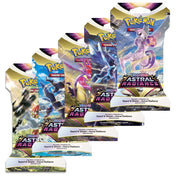As a Pokemon TCG card collector, it is important to understand and recognize the value of the cards. This can help make better decisions when buying and selling cards and build a successful collection. In this blog post we will look at how to recognize and understand the value of Pokemon TCG cards.
-
What affects the value of Pokemon TCG cards
-
How to recognize the value of Pokemon TCG cards
-
How to judge the condition of a card
-
How to maximize a card's value
What affects the value of Pokemon TCG cards
- Rarity of the card: A rarer card is usually valued higher than a common card. Cards released in limited editions are usually rated higher than cards released in larger quantities.
- Card Condition: The condition of a card has a large impact on its value. A card in perfect condition will usually be rated higher than a card that is damaged or shows signs of use.
- Card Popularity: Popular cards that are often used in the game are usually rated higher than less popular cards.
- Card Age: Older cards are often valued higher than newer cards, especially if they are rare.
How to recognize the value of Pokemon TCG cards
- Compare to price lists and online marketplaces: One way to see the value of a card is to compare it to price lists and prices on online marketplaces. There are also many online tools and websites that can estimate the value of cards.
- Advice from experienced collectors: Another way to recognize the value of a card is to seek advice from experienced collectors. They often have a good sense of card value and can help determine the value of a particular card.
- Using online card grading tools: There are many online tools that can rank cards and show a card's value. These tools often use various factors such as rarity, condition, popularity and age to calculate a card's value.
How to judge the condition of a card
- Mint (Perfect Condition): A card in mint condition has no visible signs of wear, no stains or discoloration, and no creases or dents.
- Near Mint (very good condition): A card in near mint condition has minimal signs of wear, such as light scratches
- Lightly Played: A lightly played card has visible signs of wear, such as light scratches or light stains. It may also have slight creases or dents.
- Moderately Played: A card in Moderately Played condition has more obvious signs of wear, such as deeper scratches or stains. It may also have larger kinks or dents.
- Heavily Played: A card in the Heavily Played state has signs of heavy use, such as deep scratches or stains. It can also have very large creases or dents and it can even be damaged.
How to maximize a card's value
- Store in Protective Sleeves: To maximize the value of a card, it should be stored in protective sleeves to protect it from damage and signs of wear.
- Sell in Good Condition: To maximize the value of a card, you should sell it in as good a condition as possible.
- Selling to an Appropriate Buyer: To maximize a card's value, you should sell it to a buyer who is willing to pay a higher price, such as a collector or someone who needs it for a particular deck.
In summary, the value of Pokemon TCG cards is affected by various factors such as rarity, condition, popularity, and age. To understand and maximize a card's value, compare it to price lists and online marketplaces, seek advice from experienced collectors, assess the card's condition, and sell it to a suitable buyer.
Conclusion
By understanding and recognizing the value of Pokemon TCG cards, collectors can make better choices and build a successful collection. By comparing price lists, getting advice from experienced collectors, and using online tools, you can see the value of cards. It is important to assess the condition of the cards and to consider tips for buying and selling cards.





